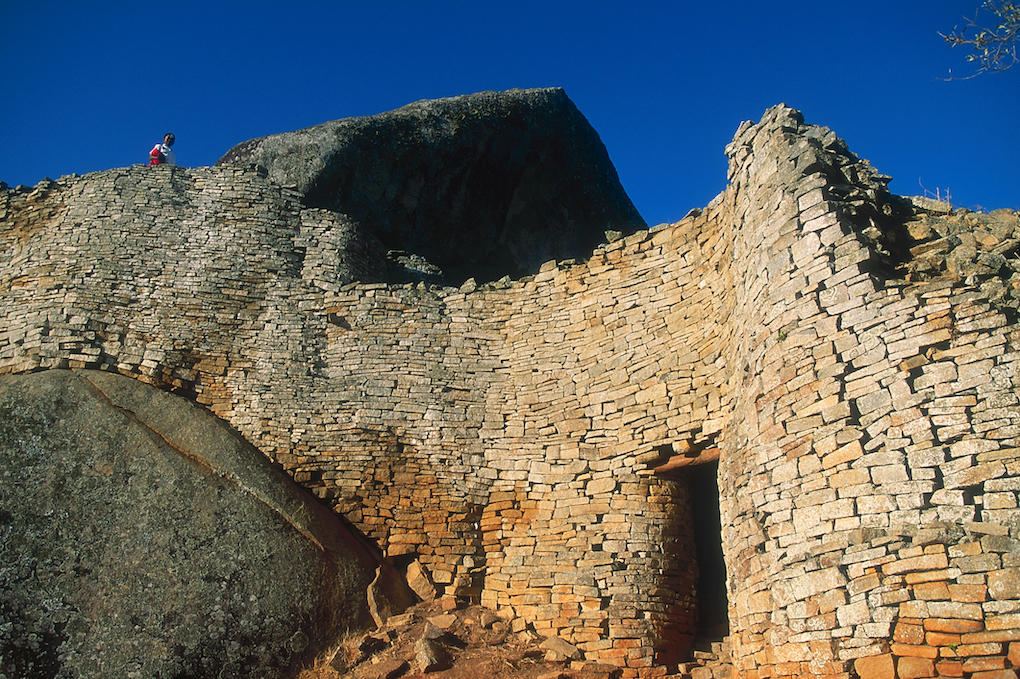The amazing works of art and architecture built during the Ancient Egypt era are among the most visited sites in the world. They attract millions of tourists every year to attest to the wonders made by the hands of the north-African people. However, in the south of the continent, lies another impressive architectural complex, whose magnificent construction and technological structure intrigues and amazes researchers— the Great Zimbabwe.
Not as popular as its northern neighbor, the Great Zimbabwe is a ruined city near Masvingo, central Zimbabwe.
The ruins at Great Zimbabwe are considered some of the oldest and largest structures located in Southern Africa. Its most formidable edifice, commonly referred to as the Great Enclosure, has walls as high as 36 ft extending approximately 820 ft, making it the largest ancient structure south of the Sahara Desert.
There, you will see many impressive monuments built using granite blocks without mortar. Those granite blocks were called zimbabwe in Bantu, hence the site and the kingdom’s name.
Bathed by numerous rivers and benefited by the abundance of soft granitic rocks, which facilitate sculpture and building, this region was home to villagers dedicated to agriculture and grazing.
Scientific research has proved that Great Zimbabwe was founded in the 11th century by a Bantu population of the Iron Age, the Shona. Their occupations are attested by the traces of increasingly large and complex residential sites.
The city prospered thanks to agriculture, gold deposits, and a trade network which reached the East African coast. They were societies stratified, in which the social and spatial division of labor and differences between classes were increasingly accentuated, until its creation as a great African empire.
In the 14th century, Great Zimbabwe was the principal city of a major state extending over the gold-rich plateaux. About 1450, the capital was abandoned because the hinterland could no longer furnish food for the overpopulated city and because of deforestation. It is also estimated that Great Zimbabwe gold mines faced exhaustion.
The resulting migration benefited Khami, which became the most influential city in the region, but signaled waning political power. When the Portuguese settled in Sofala, the region was divided between the rival powers of the kingdoms of Torwa and Mwene-Mutapa.
Archaeological excavations have revealed glass beads and porcelain from China and Persia, and gold and Arab coins from Kilwa which testify to the extent of long-standing trade with the outer world. Other evidence, including potsherds and ironware, gives a further insight to the property’s socio-economic complexity and about farming and pastoral activities. A monumental granite cross, located at a traditionally revered and sacred spiritual site, also illustrates community contact with missionaries.
The site of Great Zimbabwe was systematically looted of anything of value during the European colonialists’ activities in the area in the 1890s. Those artifacts that have found their way into the public arena are almost always without any information as to the context in which they were found.
The Great Zimbabwe has been legally protected since 1893 and is currently protected under the National Museum & Monuments Act Chapter, which provides for the legal protection of the resources within the property.
The National Museums and Monuments of Zimbabwe (NMMZ), under Zimbabwe’s Ministry of Home Affairs, is the entity directly responsible for the management of the site.
According to Travel Wild Africa, if you want to visit Great Zimbabwe driving from Victoria Falls, Bulawayo or Harare, you will first drive to the town of Masvingo. The road is narrow but well maintained. The short dirt road to the ruined city is passable for most vehicles. You’ll most likely need to stay overnight to allow yourself enough time to walk around the Great Zimbabwe Ruins.
You can also hire a guided tour of Great Zimbabwe Ruins from Bulawayo or Harare where a guide and host will drive you on your trip. Entrance Fee is $5 for Zimbabwe residents and $15 for other visitors. Please note this is subject to change without notice.
